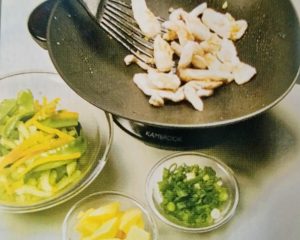How to Organize Kitchen Free Cooking Tips and Step-by-Step Guide:
Cooking Updates: Breathing there a woman who hasn’t paused midway through preparing a recipe and wished she could turn to a Grand High Poohbah Cook and ask, “How big is a medium onion, anyway?” Or, “What do I do now, if my sauce has turned to thick, dark brown syrup?”
Even the most virtuous cookbooks don’t always offer first aid hints or tell why you do a thing a certain way or what techniques make all the difference in food buying or preparation.
This sort of brooding led us to Dione Lucas, who was one of the most highly regarded cooks in America. Dione (pronounced dee-OH-nee) was one of the rare women in the world to hold a diploma from the famed Ecole du Cordon Bleu in Paris and was among the first to teach cooking via Tv (television).
Her long-running series began in 1947. Her cookbooks – the last was The Dione Lucas Book of French Cooking – are perennial sellers. The restaurants she owned or supervised were meccas for connoisseurs.
Here are some of Dione Lucas’ shortcuts, slick tricks, and magic:
Cooking Tips: For Chopping and Molding

A chopping board is one of the most “daily” essentials for you. If you don’t own one, put it at the top of tomorrow’s shopping list. It should be a block two feet by ten inches and made like a ship’s deck so there are no joints or cracks for food to lodge in. It’s better to get unvarnished wood and treat it by rubbing it with a little heated raw linseed oil. Let it dry overnight and it’ll never stain.
A large chopping knife of excellent quality is a lifelong friend. Every chef has a certain type he/she thinks is superior. Mrs. Lucas preferred the French “Sabatier” brand.
All stirring should be done with a wooden spoon. Metal chemically affects some foods. In pan-frying and sautéing, always get ur pan hot first, then add the oil or butter. Eggs – even meat – won’t stick if u use this method.
When dipping meat pieces into beaten egg and crumbs, use your left hand for applying the egg, and your right for crumbs, to avoid getting your fingers gluey.
When unmolding hot food, allow them to stand for five minutes before you turn them out on another dish. When greasing molds or pans, use oil for cold dishes and butter for hot, (butter sticks and stiffens when chilled, defeating your purpose).
Meat, Poultry, Seafood, Cooking Tips
Color guide to meet buying: Beef should be well marbled and very bright red with white fat; chicken should have fat as close to while as possible – if the pinfeather holes are close together the bird will be young and tender; veal should also be as white as possible; pork, pink with as little fat as possible; rosy-red, lamb, and not fatty.
To keep raw meat fresh and odorless, rub it with oil or dip it into its own rendered fat or melted butter before refrigerating. Don’t wrap it.
To keep raw fish fillets fresh and odorless, rinse them with water and fresh lemon juice & dry them thoroughly, and wrap and refrigerate them. Have meat at room temperature before cooking it, except meat that has been frozen. The latter can be cooked as soon as it is soft enough for the juices to begin to run. You’ll lose too much of the juice if you wait too long.
The juices will escape if pierce meat when browning. Use tong. And don’t let the pieces touch each other as they cook or they’ll stew instead of suits. Better to do some at a time than to crowd them. Brown red meats quickly, uncovered; brown poultry slowly, covered, or uncovered.
Don’t carve any sizable poultry or piece of meat right after it comes out from the oven. Give a roast, turkey, or capon at least 20 minutes and it will be much easier to slice.
Vegetables Cooking Tips
Balancing helps to keep firmness, texture, color, and flavor in such vegetables as green beans, carrots, leeks, and celery. After clicking, put the pieces in a pan and cover them with cold water. Bring slowly to a boil, drain, and then cook according to the recipe you’re using.
Test boiled potatoes for doneness with a skewer or a cake tester, don’t use a fork. Many holes make them watery. To avoid bitterness, cut off both ends of cucumbers. To bring out their taste, slice them ahead of time, sprinkle them with a pinch of salt (as per taste), and refrigerate.
To chop an onion efficiently, cut it in half and place flat surfaces on your cutting board then cut in thin slices across with the chef’s knife. Then turn slices around, holding them together, and chop them into fine pieces. This method keeps the juices in better, too. Sprinkle fresh lemon juice on the flat surfaces after you’ve cut the onions in half, to avoid tears in the process.
Never cut salad green with a knife – this bruises them and makes them bitter. Tear them gently into bite-size pieces by hand. The secret of crisp salads: Dry green thoroughly, piece by piece, till absolutely water-free. Wet salad greens won’t get shiny and coated with dressing. The best way to toss them is with your own two hands.
It’s perfectly safe and even desirable to wash and break up greens the day before they’ll be served –just wrap them in plenty of paper towels and store them in a crisper in the refrigerator. You’ll save all that last-minute work and the greens will be drier.
Dairy Foods and Eggs Cooking Tips
Heat milk slowly and stir constantly to prevent it from separating and forming a skin on top. Many cooks discard this skin, but it’s the richest part. To beat cream so it stays whipped, do it with a wire whisk in a metal bowl (not aluminum) over another bowl containing ice.
To keep cheese such as Swiss, cheddar, or hard Italian types, wrap it in waxed paper, seal it in a plastic container, and freeze it. If you grate your own Parmesan cheese as needed from a bulk chunk, you’ll enjoy four times more flavor than from the pre-grated kind.
Dip the chunk in brandy and wrap it in plastic, then foil, to preserve its freshness; it needn’t be refrigerated. Swiss cheese also stores well by using this method, but it should be refrigerated. Brandy used for preserving and dipping can be saved and used again for these purposes.
When cooking with raw eggs, you’ll get the best results if the eggs have just come out of the refrigerator. They separate better and thicken mayonnaise or hollandaise sauce faster. Egg whites are well-whipped if they adhere to the bowl when you turn it upside down. Hand-beat them in a metal bowl when you turn them upside down.
Hand-beat them in a metal bowl (not aluminum) with a wire whisk to get more air, thus more volume. This is especially important for soufflés, where the whites must hold up your creation. It’ll also keep the whites from getting too dry from over-beating.
Poach eggs in water flavored with tarragon vinegar for a subtle, delicate taste.
Recent Posts
Seasonings
Garlic guide: Never cook garlic fast; never cook it alone. Chop it in a little salt and the pieces won’t stick to your knife or your cutting board. Then pulverize it with the tip of the knife to make it dissolve. Don’t use a garlic press – you lose the best part of the bud.
Garlic should be as fresh as your salad greens. If you let it sit around too long, it becomes dry and tasteless. To sweeten garlic-scented fingers, rub them with a ripe tomato which you can use later in a salad; if the scent is very powerful, rub your fingers in coffee grounds.
To keep dill, mint, or tarragon fresh, wash and dry well, then strip springs from stalks and refrigerate in a screw-top jar. Rub dry herbs between your fingers or rehydrate them with a little water to bring out their fragrance. Vanilla sugar, wonderful for flavoring, can be made by putting a vanilla bean in a jar of sugar.
Sauces
Add flour to melted butter off the heat for a smoother mixture. When adding any liquid to a sauce base, stir it in off the heat. Add hot sauce to cold sauce two tablespoons at a time so the cold warms up gradually and doesn’t curdle. Recommended stirring technique: use a wooden spatula or a wire whisk and scrape over the bottom of the pan as you stir.
To beat sour cream into a hot mixture, take a dab of it on a rubber scraper, scrape it off with a wire whisk, and quickly, lightly beat it into the sauce, which must be kept under the boiling point. Continue until all the cream is added.
The secret of a good sauce: low-to-medium heat, never high. To correct a separated sauce: if hollandaise or chocolate, beat in a tablespoon or so of cold water; use hot water for mayonnaise. To correct a too-thick sauce: heat until simmering, then beat, a spoonful at a time, a little cream or stock until the consistency is right.
To correct a too-thin hot sauce: blend a teaspoon of flour with a teaspoon of soft butter. Beat into hot sauce off heat until smooth. Simmer.

Right here is the perfect site for anybody who would like to find out
about this topic. You understand so much its
almost tough to argue with you (not that I actually would want
to…HaHa). You definitely put a new spin on a subject that’s been discussed for ages.
Wonderful stuff, just great!